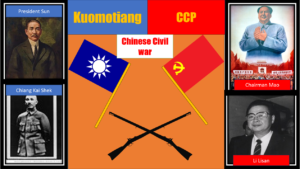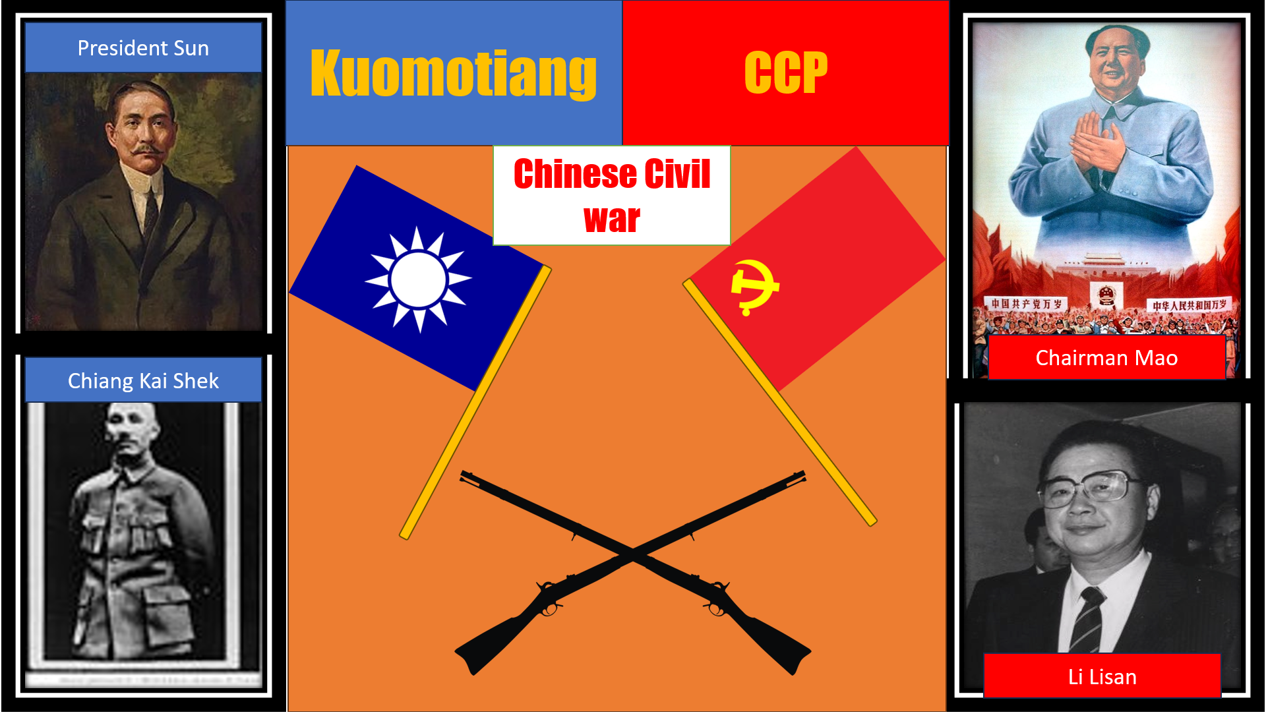
Have you ever heard of the word Maoist in Newspapers and wondered what it is? Have you seen the flag of a country with five golden stars and the rest of it red, China. Wondered what it is?
To start with we must go to the Taiping rebellion, which started just after the publishing of the communist manifesto. The Taiping revolution sought to overthrow the class system in China and the corrupt Qing dynasty. Unfortunately, the Taiping heavenly kingdom only last for few years, and qing dynasty gained victory.
Still, it was not powerful because the Japanese are attacking, Qing ruled China was plagued regionalism as several provinces in China was ruled by regional warlords degrading the qing power, foreign merchants plaguing China with neo-colonialism (opposed by boxer rebellion, opium wars and etc). So, you see the political conditions in China was ugly.
Few decades later a two-year-old, emperor Puyi heir of throne took over, taking the advantage his mother took the throne as the regent ruler. This only worsened the lively hood of the citizens of China.
Dr Sun Yat Sen who was still in exhaled revolutionary of the Chinese nationalist Kuomintang (KMT, a political party against the Qing regime, seeks democratic reforms) saw the political conditions of the current China as ripe for revolution. He was still exiled but the revolution started in 1911 using the help of other KMT revolutionaries. This revolution is called by many names Xhinhai revolution, 1911 revolution, Hsinsai revolution or etc.
As we all know only people with a large number of armed forces get political power, The same way the KMT sought alliance with general Yuan Shikai, The general of the emperor Puyi. Yuan Shikai was happy to switch sides from the Qing dynasty to the KMT.
Later Yuan Shikai became the first president of the Republic of China Instead of Sun Yat Sen. General Yuan lacked a refined Ideology and wanted to restore the monarchy and titled himself emperor. His rule was opposed by the KMT greatly. Finally, there came a power vacuum in order to the death of general Yuan.
The vacuum deleted by the KMT, and the president was Dr. Sun Yat Sen.
After that, the Chinese communist party(CCP) was founded by Chen Duxiu and Li Dazhao one of the first people to publicly support Leninism, agents from the Comintern (An international organization by the Soviet union to coordinate international revolutions), few Chinese intellectuals and Participants of the May 4th movement ( Chinese cultural and anti-imperialist political movement which grew out of student protests in Beijing on May 4, 1919) in Shanghai at 1921.
During that time KMT was seeking help from other nations for unification of China free from warlordism and regionalism. No one tried to help except for the Soviet Union and the CCP.
In 1923, Sun and Soviet representative Adolph Joffe in Shanghai pledged Soviet assistance to China’s unification in the Sun–Joffe Manifesto, a declaration of cooperation among the Comintern, KMT, and the Chinese Communist Party (CCP). Comintern agent Mikhail Borodin arrived in 1923 to aid in the reorganization and consolidation of both the CCP and the KMT along with of the Communist Party of the Soviet Union. This formed the first united front.
In this period, the CCP became too dependent on the KMT as there were just 300 members in 1922 and the membership was increased to 1500 only in 1925(ironically it is the second largest political party in the world right now. In comparison the KMT was having 50000 members. It was so small that Communist members were allowed to join the KMT on an individual basis.
However, after Sun died in 1925, the KMT split into left- and right-wing movements. KMT members worried that the Soviets were trying to destroy the KMT from inside using the CCP. The CCP then began movements in opposition of the Northern Expedition (a movement that, passing a resolution against it at a party meeting.
So, friends I am going to tell a surprise that the civil war has not even started until this part, yes, it started only when Sun’s Anti-communist successor (as the leader of the KMT) started the Shanghai massacre (A massacre that killed the communists) in 1927. This event commenced the 1st united front, the alliance between the KMT and CCP.
This incident widened the rift between Chiang and Wang Jingwei, the leader of the left-wing faction of the left wing of the KMT also expelled CCP members from the Wuhan government, which in turn was toppled by Chiang Kai-shek.
The leftists rejected Chiang’s demand to eliminate Communist influence within KMT, and Chiang denounced them for betraying Sun Yat-sen’s Three Principles of the People (The ideology of the KMT, Nationalism, Democracy, Lively hood of people) by taking orders from the Soviet Union. According to Mao Zedong (communist revolutionary and one of the founders of the CCP), Chiang’s tolerance of the CCP in the KMT camp decreased as his power increased.
On 1 August 1927, the Communist Party launched an uprising in Nanchang against the Nationalist government in Wuhan. This conflict led to the controversial creation of the workers and peasant’s Red Army which fought against the KMT’s National Revolutionary Army.
Few months later in September 1927 Mao Zedong (one of the most important CCP revolutionaries led a revolt in the Hunan province. This revolt is known as Autmn harvest uprising. Though his revolts were initially unsuccessful this set base for Mao’s later concepts on rural-based communist revolution.
The KMT launches series of attacks against the CCP base areas in Jiangxi. Despite significant resistance, the CCP suffers heavy losses and is eventually forced to abandon their base.
The Red Army embarks on a gruelling 6,000-mile retreat from Jiangxi to Shaanxi, suffering immense hardships. Mao Zedong emerges as the undisputed leader of the CCP during this period, advocating that guerrilla warfare (Guerrilla warfare is a type of fighting where small groups use surprise attacks, know the land well, blend in with civilians, and make the most of limited resources to outsmart a larger enemy.) and establishing a new base in Yan ‘an.
Now we have seen that the KMT and CCP does not have a very good relationship with each other until this part, but Mao realizes that its time for CCP and KMT to be united. You may think it is very dumb to be friends with someone you hate. But Mao had a reason for it. Even thought CCP and KMT had opposing ideals, they both hated Japanese and western Imperialism. So, in order to fight the war, they both had to make a temporary alliance with each other to fight against the Japanese (second Sino-Japanese war). Though leader of the KMT, Generalissimo Chiang Kai Shek disagreed, the other KMT higher officials forced him to accept Mao’s offer. Therefore, the second united front was ended.
While 1937-1945 even while fighting against the Japanese, the CCP focuses on expanding its influence in rural areas. Due to this the CCP significantly increases its membership and territorial control.
The CCP launches a large-scale military campaign against Japanese forces in North China known as the Hundred regiments offensive in 1940, demonstrating their growing military capabilities.
The end of World War II as well as the second Sino Japanese war (China’s victory) leaves a power vacuum in China. The CCP quickly moves to occupy Japanese-held territories and consolidate power in the north.
In 1946 the second united front alliance was over as the negotiations between the KMT and the CCP broke down. The KMT initially gains the upper hand with superior numbers and equipment.
With further campaigns from 1946-49 diminished the KMT power such as the Liu and Deng’s Huaihai Campaign, Liaoshen Campaign and the Pingjin Campaign proved Mao’s leadership was proved effective and successful.
Finally in April 1949 Yangtze River was crossed by the red army troops, causing the fall of KMT’s capital city Nanjing, as it was taken over by red army.
Finally, the red republic was proclaimed in October 1949 as Peoples Republic of China (PRC), and the KMT retreated to Taiwan. The Repulic of China withdrew from the UN security council, and PRC.
Now you might be wondering what the CCP did after their ambitious revolution for the improvement of the people’s life. Here is what Mao did:
- Even though Mao had a vision for a socialist society, he did some reforms that collaborated with the national bourgeoise. Yes, though they won the civil war they still had to worry about colonialism by international bourgeoise which exploited the Chinese proletariat. So, Mao collaborated with the national bourgeoise to beat the international bourgeoise. This also aimed in deleting the semi feudalism in China.
- Mao did the land reform to abolish the inequality of wealth in China. This empowered the poor landless farmers and peasants.
- Mao pursued collectivization of agriculture, forming agricultural cooperatives and later communes. This move aimed to increase agricultural productivity and consolidate political control.
- Cult of personality was huge in China. In fact, a separate revolution happened to Mao cult of personality propaganda. Even though there were dozens of good things that happened to the people of China, I personally think cult of personality is a dangerous and evil thing. In the 1960s, Mao launched the Cultural Revolution, aiming to purge remnants of capitalist and traditional elements from Chinese society and to reassert his ideological dominance within the Communist Party. This led to widespread social upheaval and political persecution.
- Mao implemented several Five-Year Plans (for planning the Chines economy and industrializing it), following the Soviet model, to prioritize industrialization and economic development. These plans focused on expanding heavy industry, such as steel production, to strengthen the Chinese economy.
- Mao also launched the great leap forward, which attempted to improve agricultural methods, and to strengthen the economy.
Now we saw about the achievements of the newly formed revolutionary government, now we shall see the ideology based on which the government was running. This ideology is known as Maoism, here is a summary detailing what Maoism is:
- Marxism-Leninism Adaptation: Mao adapted Marxist-Leninist principles to the specific conditions of China, which was mostly agrarian and semi-feudal at the time. He emphasized the role of the peasantry as the revolutionary class, alongside the industrial proletariat. This is why Maoism is also known as Marxism-Leninism Maoism
- Protracted People’s War: Maoism advocates for a prolonged revolutionary struggle, particularly in agrarian societies, using guerrilla warfare tactics. The strategy involves gradually encircling and capturing cities from the countryside.
- Mass Line: Mao stressed the importance of maintaining close ties with the masses and understanding their needs and aspirations. The “mass line” involves integrating the ideas and feedback of the masses into policy decisions. This is the exact opposition of the statement; China is very undemocratic.
- New Democracy: Mao proposed a transitional stage between capitalism and socialism, known as New Democracy, where revolutionary forces unite to overthrow imperialism and feudalism. This is proved as Mao collaborated with national bourgeoise to beat the international bourgeoise economically to end colonialism.
- Self-reliance: Maoism advocates for economic self-reliance and independence from foreign powers.
Maoism remains an important part of Chinese Communist Party ideology, although its influence has waxed and waned over time. While Mao’s ideas were pivotal in shaping China’s revolutionary and early socialist period, subsequent Chinese leaders have adopted more pragmatic and market-oriented policies, leading to a reassessment of Mao’s legacy within China. Nonetheless, Mao Zedong Thought continues to be studied and debated both within China and in other parts of the world.

Leave a Reply